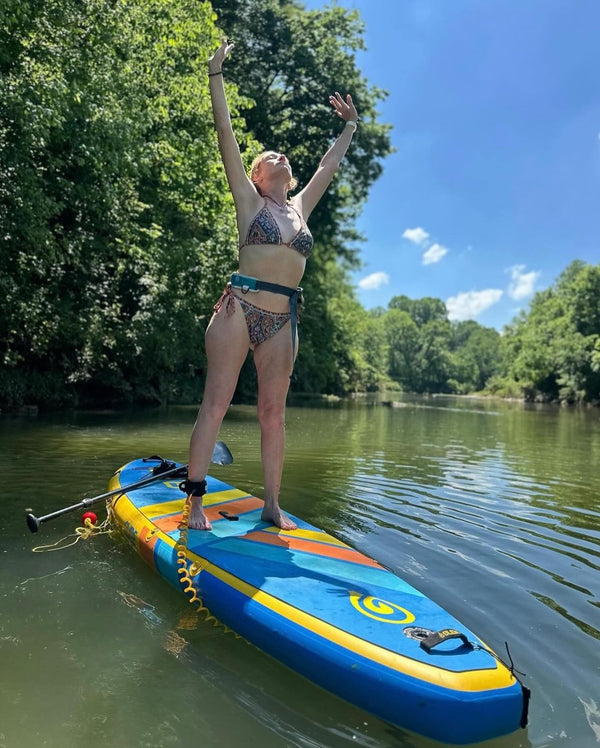
How to Keep Your Feet from Going Numb on a Stand Up Paddle Board
If you’re new to paddle boarding or even if you’ve been doing it for a while, you might encounter two common issues: numb feet and difficulty moving around on your board.
Stand up paddle boarding (SUP) is a fantastic way to enjoy the water, combining exercise with the serenity of being outdoors. However, if you’re new to paddle boarding or even if you’ve been doing it for a while, you might encounter two common issues: numb feet and difficulty moving around on your board. Both of these can take away from the enjoyment of your paddle boarding experience. Fortunately, there are some simple techniques and tips to help you stay comfortable and mobile on your board. Let's dive into how you can keep your feet from going numb and move around with ease on your SUP.

Why Your Feet Might Go Numb
Before we get into the solutions, it’s helpful to understand why your feet might go numb in the first place. Standing on a paddle board involves balancing on a flat surface for extended periods. This can reduce circulation to your feet and cause numbness. The pressure on your feet, coupled with the need to maintain balance, can lead to discomfort.
Tips to Prevent Numb Feet
1. Move Your Feet Periodically
One of the easiest ways to prevent numb feet is to shift your weight and move your feet periodically. Try lifting your heels, wiggling your toes, or even shifting from one foot to the other. This helps maintain circulation and reduces the pressure on any single part of your foot.
2. Adjust Your Stance
Experiment with different stances to find what works best for you. A slightly wider stance can help distribute your weight more evenly. Bend your knees slightly to keep a low center of gravity and reduce the strain on your feet.
3. Wear Comfortable Footwear

Consider wearing neoprene booties or SUP-specific shoes. These can provide extra cushioning and support, reducing the direct pressure on your feet. Make sure the footwear is snug but not too tight to avoid restricting circulation.
4. Take Breaks
If you feel your feet starting to go numb, take a break. Sit or kneel on your board for a few minutes to relieve the pressure. This can help restore circulation and give your feet a much-needed rest. Glide inflatable paddle boards come with a kayak seat which is a great way to give your feet a break.
Moving Around on Your Paddle Board Helps
Moving around on your paddle board can be a bit intimidating at first, but it’s a crucial skill to master for better control and versatility as well as keeping your feet from going numb. Whether you need to adjust your position for paddling efficiency, avoid obstacles, or just stretch your legs, here’s how to move confidently on your board.
1. Start with a Stable Stance
Begin by standing with your feet shoulder-width apart, knees slightly bent, and weight evenly distributed. This is your stable base. From here, you can practice shifting your weight and taking small steps.
2. Use the Paddle for Balance
Your paddle is not just for propulsion; it can also be a great tool for balance. When moving around, keep your paddle in the water on one side to help steady yourself. This gives you an extra point of contact and can prevent falls.
3. Take Small Steps
When you need to move, start with small, deliberate steps. Move one foot at a time, keeping the other foot planted firmly on the board. This reduces the risk of losing balance. Gradually, as you become more comfortable, you can take larger steps.
4. Practice Shifting Positions
Practice shifting from a standing to a kneeling position and vice versa. This is especially useful for navigating rough water or making quick adjustments. To kneel, place your paddle across the board in front of you, lower one knee at a time, and keep your weight centered. To stand back up, reverse the process.
5. Rotate Your Hips
When you need to turn or pivot on your board, rotate your hips rather than your feet. This helps maintain your balance and allows you to turn more smoothly. Engage your core and use your paddle for additional support.
Final Thoughts

Keeping your feet from going numb and moving around on your stand-up paddle board are essential skills for a comfortable and enjoyable paddling experience. By incorporating these tips into your routine, you’ll find yourself more confident and capable on the water. Remember, practice makes perfect, so take the time to get comfortable with these techniques. Whether you’re out for a leisurely paddle or tackling more challenging conditions, these skills will enhance your SUP adventures.


